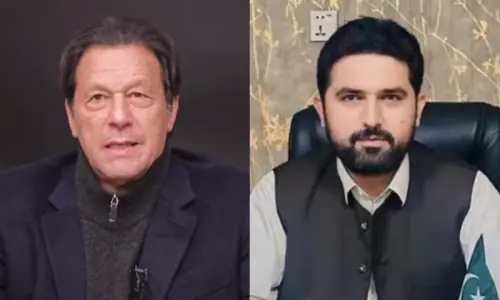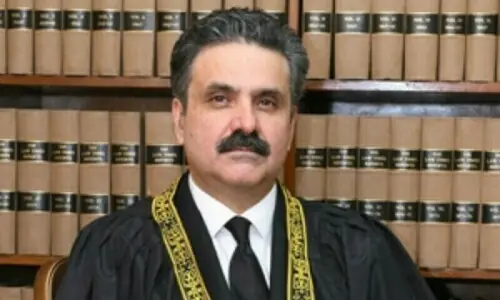For most of its history, Pakistan has only known one Pir Pagara: Shah Mardan Shah II, leader of the Hur Jamaat, occupant of the Pir Jo Goth-based gaddi (spiritual seat) and head of the Pakistan Muslim League-Functional, known to most for his cryptic one-liners that often alluded to the fact that a military takeover was imminent.
Yet with Pir Pagara’s death in January 2012, his eldest son Syed Sibghatullah Shah Rashdi, named after his famed grandfather — the suryeh badshah of Sindh whom the British sent to the gallows in 1943 — was anointed the eighth Pir Pagara, while also assuming the PML-F’s mantle of leadership.
Though the new Pir Pagara inherited both his politics and his gaddi from his father, Raja Saeen, as he his popularly known, he has begun to make a mark for himself in Sindh’s politics; as the events of the last few months have shown, the son also rises.
In his mid-50s, the new Pir Pagara is naturally a different man than his father, who had the temperament of another age. According to those who have observed both father and son, the elder Pagara was not too social, even though most politicians made a beeline for Kingri House, the Pir’s residence in Karachi’s swanky KDA Scheme 1 neighbourhood, for his ‘blessings’ and advice.
However Raja Saeen is a man with a very different approach to politics. Watchers of the new Pir say he is a much more sociable man and is comfortable in large gatherings. Many thought that Sadruddin Shah Rashdi, Raja Saeen’s younger brother commonly known as Younus Saeen, would steer the PML’F-s politics. Yet like his father Younus Saeen is a more reserved man while Raja Saeen is more of a people person. Naturally, after the elder Pagara’s demise the PML-F’s activities in Karachi have shifted from Kingri House to Raja House, residence of the new Pir.
Perhaps Pir Pagara’s biggest achievement so far has been the fact that he has cobbled together a 10-party coalition in Sindh to take on the Pakistan Peoples Party’s electoral dominance in what is seen as the PPP’s ‘home’ province.
The alliance under Pir Pagara’s stewardship is something of a motley crew consisting, along with the PML-F, of rightist religious parties such as the Jamaat-i-Islami and the Jamiat Ulema-i-Islam-Fazl, centrists such as the Pakistan Muslim League-Nawaz as well as left-leaning Sindhi nationalist parties such as the Qaumi Awami Tehreek and the Sindh Taraqqi-pasand Party.
There are two ways of looking at the alliance. According to the first, the 10-party grouping is an example of Pir Pagara’s political acumen and skill, marshalling as he has the disparate anti-PPP tribes in Sindh. The second view says this is more of an opportunistic set-up not much different from the Islami Jamhoori Ittehad, driven not by a common political agenda, but by a visceral hatred of the PPP.
Whatever the truth of the matter, the fact is Raja Saeen has kept his confederates from going their own way till now, though there are rumblings that the Sunni Tehreek, another component party, is dissatisfied with nominations and may part ways.
There may also be further cracks, as the QAT and STP also do not see eye to eye on a few seats.
Of course Raja Saeen is no political novice. He has been elected to the Sindh Assembly at least three times and has served as a provincial minister. Yet this was all during his father’s lifetime. What really brought him to the fore as a leader of prominence was a hard-hitting speech at a largely attended jalsa in Hyderabad in December 2012.
At the rally Pir Pagara slammed the now repealed local government law passed by the PPP government, reportedly to appease its then coalition partner the Muttahida Qaumi Movement. Of course the PML-F had earlier left the ruling coalition due to the passage of the Sindh Local Government Ordinance. The rally made many, including the PPP, take notice and endeared Pir Pagara to Sindhi nationalists, who despised the SLGO. It can be said that the successful Hyderabad jalsa contained within it the seeds of the present Pagara-led coalition.
What does the future, especially where the 2013 polls are concerned, hold for Pir Pagara and his followers, both political and spiritual? The 10-party alliance has fielded over 20 candidates for the national assembly and nearly 40 for the Sindh Assembly.
Yet it may not be an easy ride into the assembly for the Pir and his disciples.
Firstly, the alliance has no charismatic leader apart from Raja Saeen. As hinted at earlier, some leaders of the other component parties are prone to infighting and may kill any effective chances of putting up a strong united front.
Secondly, while there is disaffection with the PPP in Sindh, it remains to be seen whether these negative feelings will translate into major votes for the PPP’s opponents. After all, Raja Saeen is no revolutionary and is in fact a scion of the old order, where mirs, pirs and faquirs have dominated and continue to dominate Sindh’s politics. So while the voter in Sindh is well aware of the PPP’s broken promises, he also knows that most of the party’s opponents represent the status quo.
Yet with Raja Saeen’s head-first dive into politics, the political scene in Sindh has certainly livened up, as ‘bhej Pagara’ tries to compete with the PPP’s battle cry of ‘Jeay Bhutto’ and Pir Jo Goth tries to challenge Larkana’s dominance of Sindh’s politics. Whatever the results on May 11, Pir Pagara will surely be a force to watch out for in Sindh’s colourful political landscape.

































